brake YAMAHA BANSHEE 350 2006 Notices Demploi (in French)
[x] Cancel search | Manufacturer: YAMAHA, Model Year: 2006, Model line: BANSHEE 350, Model: YAMAHA BANSHEE 350 2006Pages: 400, PDF Size: 3.59 MB
Page 104 of 400
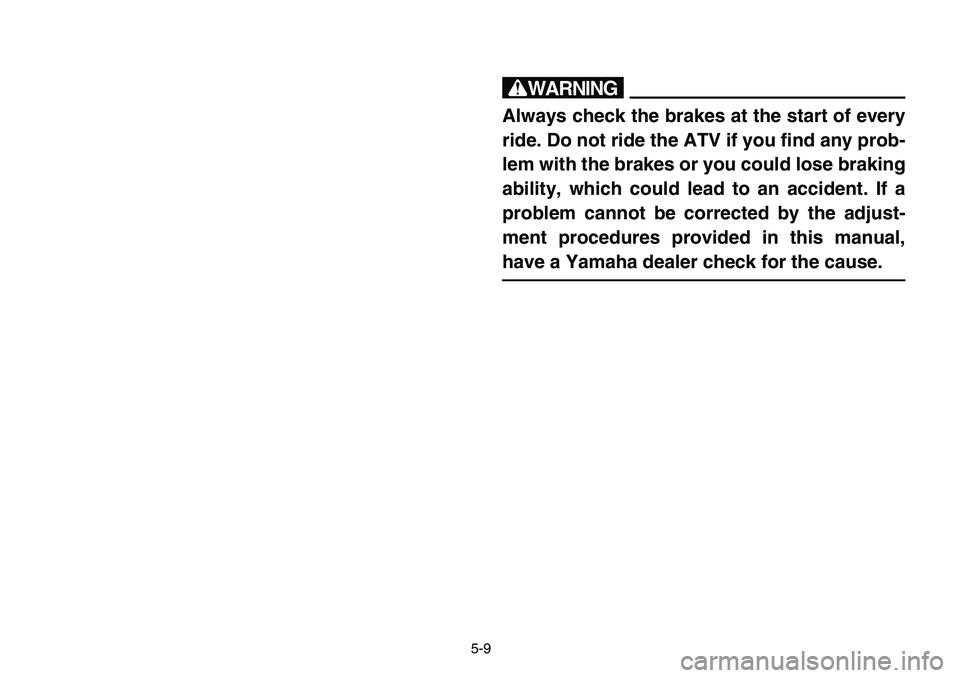
5-9
w
Always check the brakes at the start of every
ride. Do not ride the ATV if you find any prob-
lem with the brakes or you could lose braking
ability, which could lead to an accident. If a
problem cannot be corrected by the adjust-
ment procedures provided in this manual,
have a Yamaha dealer check for the cause.
Page 126 of 400
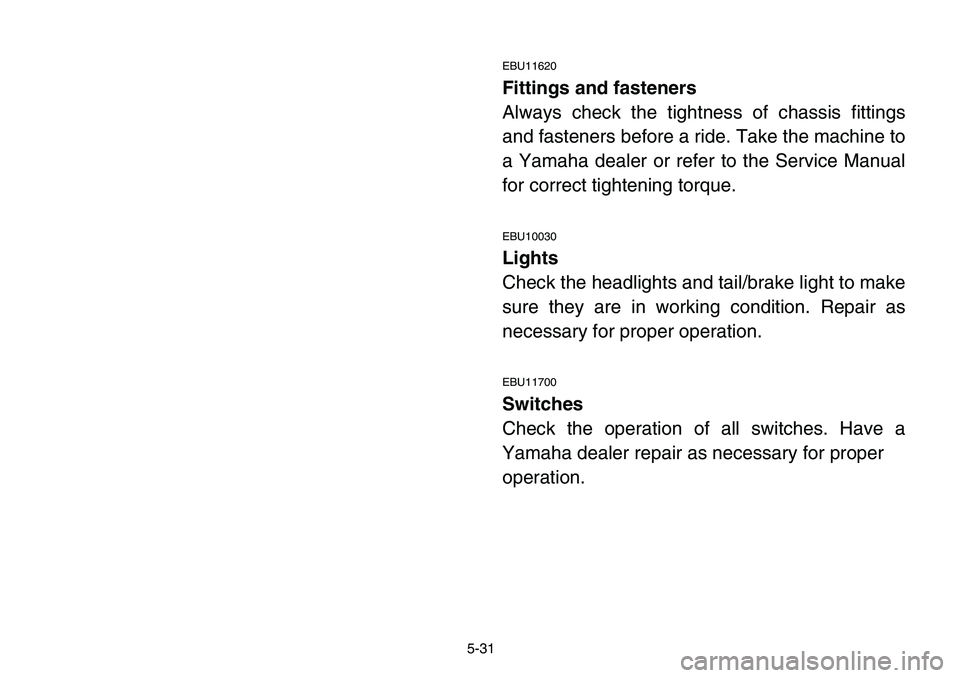
5-31
EBU11620
Fittings and fasteners
Always check the tightness of chassis fittings
and fasteners before a ride. Take the machine to
a Yamaha dealer or refer to the Service Manual
for correct tightening torque.
EBU10030
Lights
Check the headlights and tail/brake light to make
sure they are in working condition. Repair as
necessary for proper operation.
EBU11700
Switches
Check the operation of all switches. Have a
Yamaha dealer repair as necessary for proper
operation.
Page 130 of 400
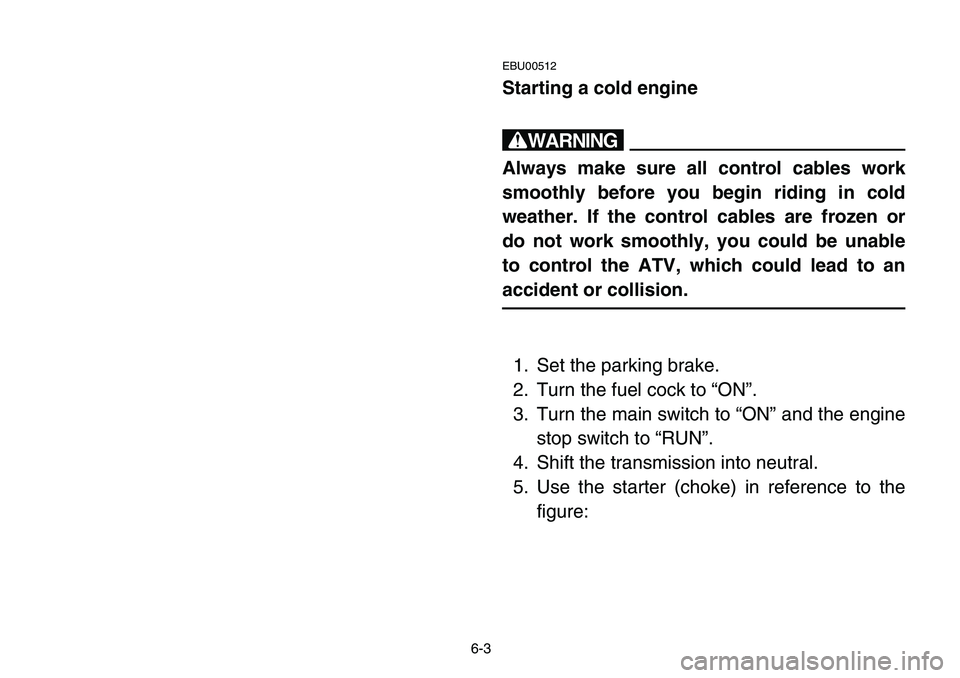
6-3
EBU00512
Starting a cold engine
w
Always make sure all control cables work
smoothly before you begin riding in cold
weather. If the control cables are frozen or
do not work smoothly, you could be unable
to control the ATV, which could lead to an
accident or collision.
1. Set the parking brake.
2. Turn the fuel cock to “ON”.
3. Turn the main switch to “ON” and the engine
stop switch to “RUN”.
4. Shift the transmission into neutral.
5. Use the starter (choke) in reference to the
figure:
Page 136 of 400
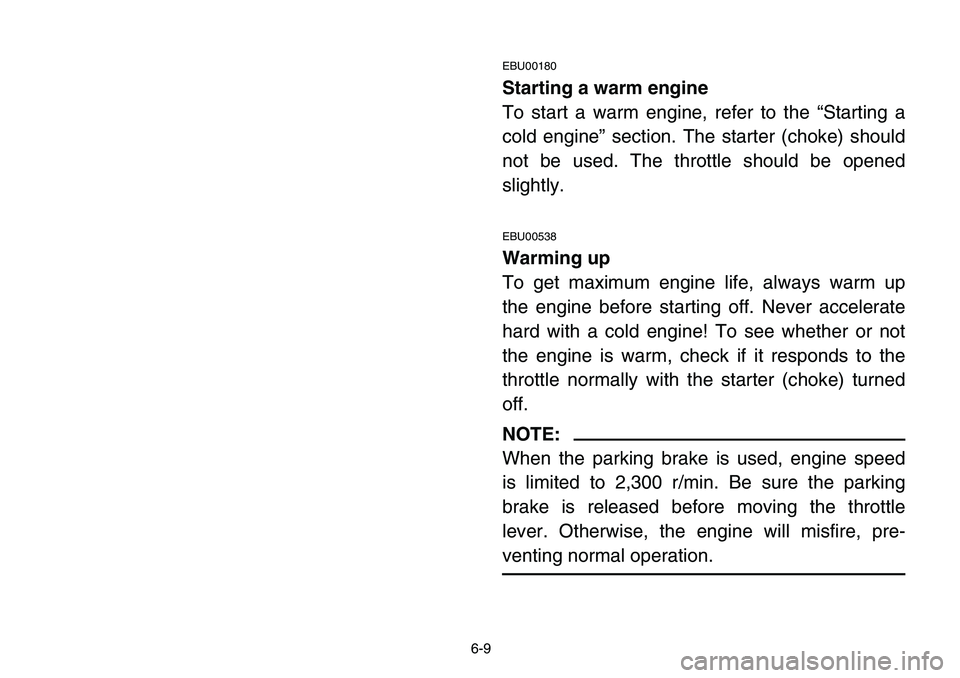
6-9
EBU00180
Starting a warm engine
To start a warm engine, refer to the “Starting a
cold engine” section. The starter (choke) should
not be used. The throttle should be opened
slightly.
EBU00538
Warming up
To get maximum engine life, always warm up
the engine before starting off. Never accelerate
hard with a cold engine! To see whether or not
the engine is warm, check if it responds to the
throttle normally with the starter (choke) turned
off.
NOTE:
When the parking brake is used, engine speed
is limited to 2,300 r/min. Be sure the parking
brake is released before moving the throttle
lever. Otherwise, the engine will misfire, pre-
venting normal operation.
Page 146 of 400
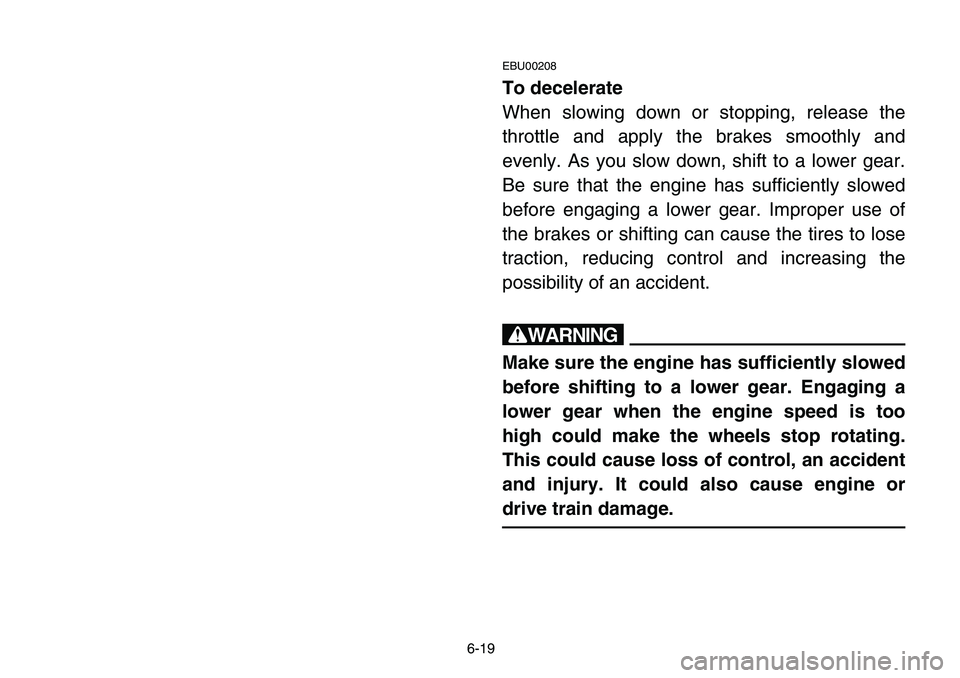
6-19
EBU00208
To decelerate
When slowing down or stopping, release the
throttle and apply the brakes smoothly and
evenly. As you slow down, shift to a lower gear.
Be sure that the engine has sufficiently slowed
before engaging a lower gear. Improper use of
the brakes or shifting can cause the tires to lose
traction, reducing control and increasing the
possibility of an accident.
w
Make sure the engine has sufficiently slowed
before shifting to a lower gear. Engaging a
lower gear when the engine speed is too
high could make the wheels stop rotating.
This could cause loss of control, an accident
and injury. It could also cause engine or
drive train damage.
Page 152 of 400
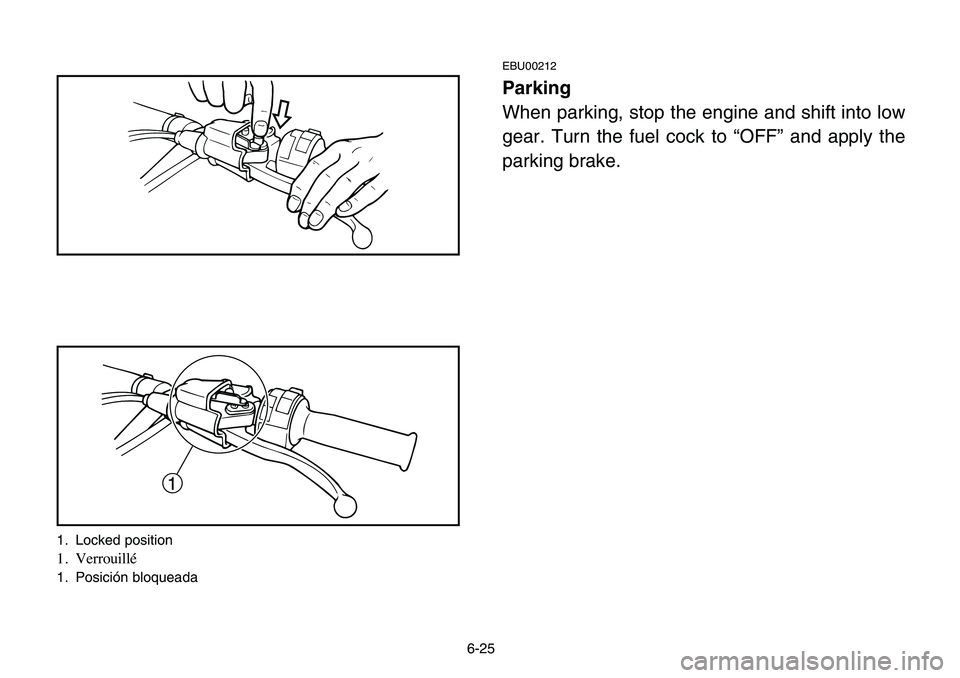
6-25
EBU00212
Parking
When parking, stop the engine and shift into low
gear. Turn the fuel cock to “OFF” and apply the
parking brake.
1
1. Locked position
1. Verrouillé
1. Posición bloqueada
Page 154 of 400
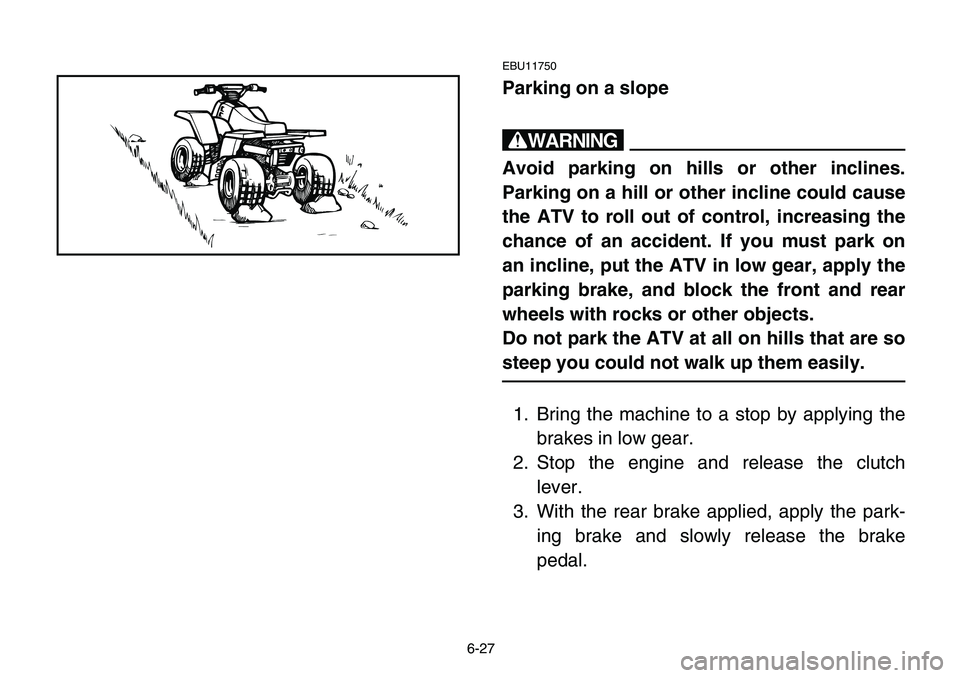
6-27
EBU11750
Parking on a slope
w
Avoid parking on hills or other inclines.
Parking on a hill or other incline could cause
the ATV to roll out of control, increasing the
chance of an accident. If you must park on
an incline, put the ATV in low gear, apply the
parking brake, and block the front and rear
wheels with rocks or other objects.
Do not park the ATV at all on hills that are so
steep you could not walk up them easily.
1. Bring the machine to a stop by applying the
brakes in low gear.
2. Stop the engine and release the clutch
lever.
3. With the rear brake applied, apply the park-
ing brake and slowly release the brake
pedal.
Page 200 of 400
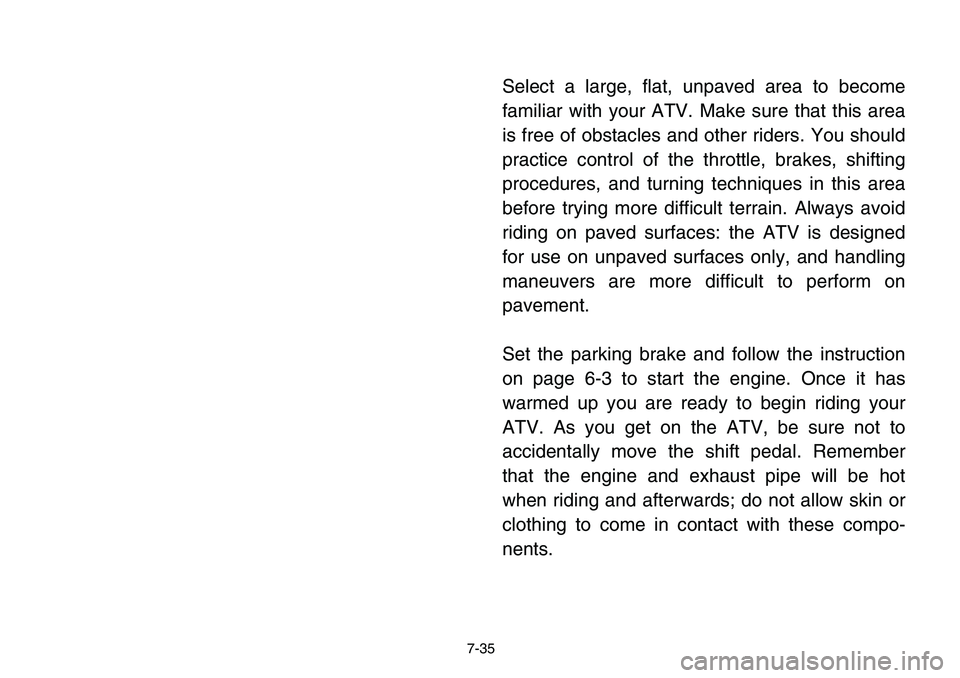
7-35
Select a large, flat, unpaved area to become
familiar with your ATV. Make sure that this area
is free of obstacles and other riders. You should
practice control of the throttle, brakes, shifting
procedures, and turning techniques in this area
before trying more difficult terrain. Always avoid
riding on paved surfaces: the ATV is designed
for use on unpaved surfaces only, and handling
maneuvers are more difficult to perform on
pavement.
Set the parking brake and follow the instruction
on page 6-3 to start the engine. Once it has
warmed up you are ready to begin riding your
ATV. As you get on the ATV, be sure not to
accidentally move the shift pedal. Remember
that the engine and exhaust pipe will be hot
when riding and afterwards; do not allow skin or
clothing to come in contact with these compo-
nents.
Page 202 of 400
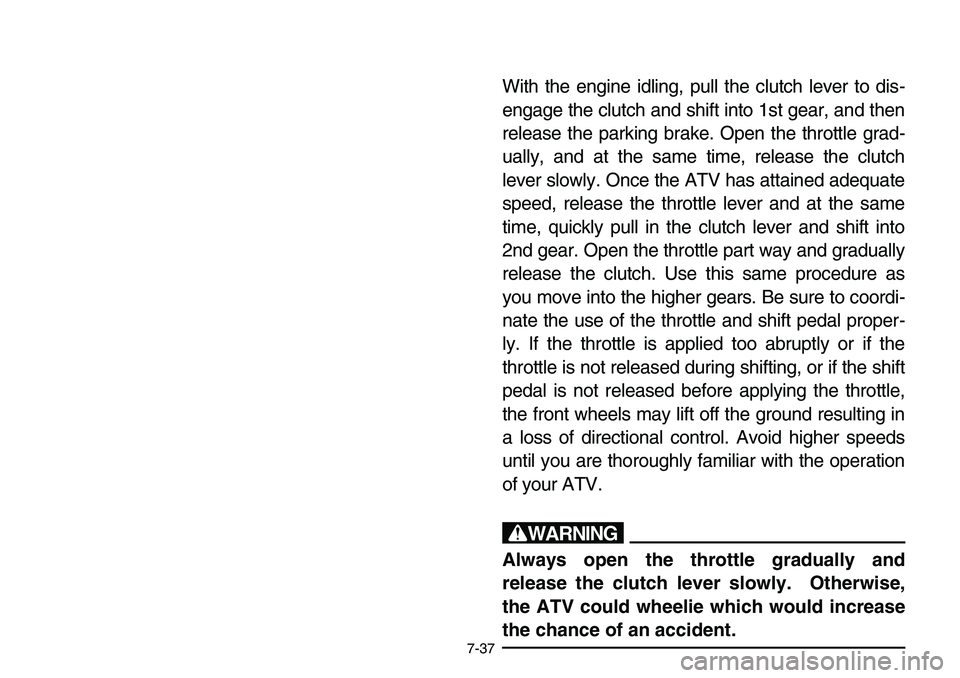
7-37
With the engine idling, pull the clutch lever to dis-
engage the clutch and shift into 1st gear, and then
release the parking brake. Open the throttle grad-
ually, and at the same time, release the clutch
lever slowly. Once the ATV has attained adequate
speed, release the throttle lever and at the same
time, quickly pull in the clutch lever and shift into
2nd gear. Open the throttle part way and gradually
release the clutch. Use this same procedure as
you move into the higher gears. Be sure to coordi-
nate the use of the throttle and shift pedal proper-
ly. If the throttle is applied too abruptly or if the
throttle is not released during shifting, or if the shift
pedal is not released before applying the throttle,
the front wheels may lift off the ground resulting in
a loss of directional control. Avoid higher speeds
until you are thoroughly familiar with the operation
of your ATV.
w
Always open the throttle gradually and
release the clutch lever slowly. Otherwise,
the ATV could wheelie which would increase
the chance of an accident.
Page 204 of 400
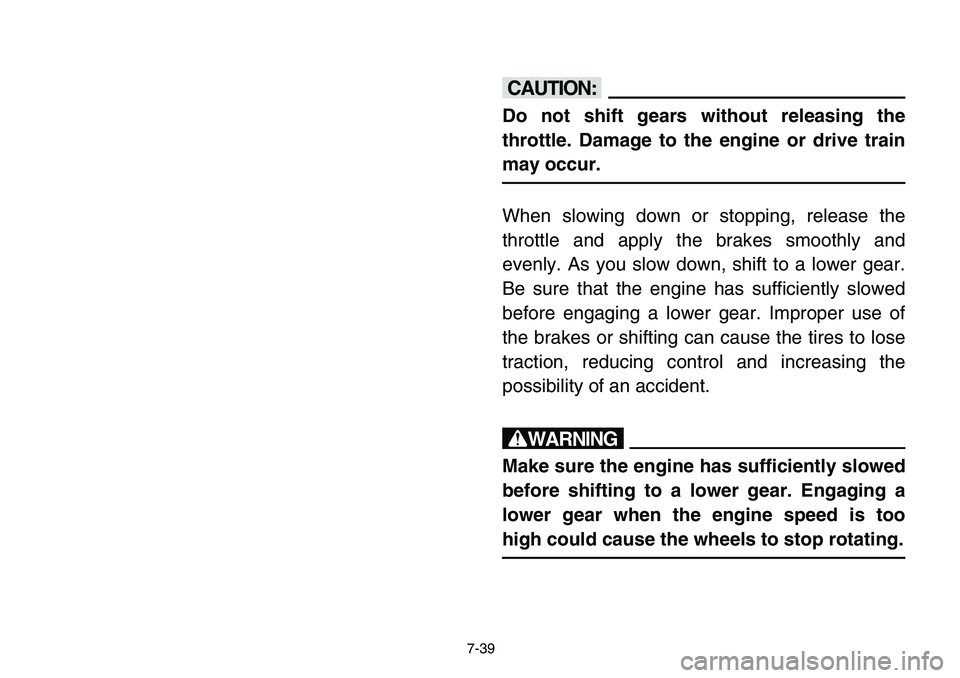
7-39
cC
Do not shift gears without releasing the
throttle. Damage to the engine or drive train
may occur.
When slowing down or stopping, release the
throttle and apply the brakes smoothly and
evenly. As you slow down, shift to a lower gear.
Be sure that the engine has sufficiently slowed
before engaging a lower gear. Improper use of
the brakes or shifting can cause the tires to lose
traction, reducing control and increasing the
possibility of an accident.
w
Make sure the engine has sufficiently slowed
before shifting to a lower gear. Engaging a
lower gear when the engine speed is too
high could cause the wheels to stop rotating.